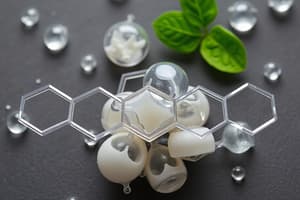Podcast
Questions and Answers
What is the structure of fatty acids?
What is the structure of fatty acids?
Hydrophobic hydrocarbon chain and hydrophilic carboxyl group (ionized at pH 7). Amphipathic.
What characterizes saturated fatty acids?
What characterizes saturated fatty acids?
- No double bonds (correct)
- Contain double bonds
- Hydrophilic
- Amphipathic
What describes unsaturated fatty acids?
What describes unsaturated fatty acids?
- No double bonds
- Contain one or more double bonds (correct)
- Higher melting temperature (Tm)
- Lower fluidity
Increasing chain length decreases the melting temperature (Tm) of fatty acids.
Increasing chain length decreases the melting temperature (Tm) of fatty acids.
What is carbon 1 of fatty acids called?
What is carbon 1 of fatty acids called?
What is carbon 2 of fatty acids referred to as?
What is carbon 2 of fatty acids referred to as?
What is carbon 3 of fatty acids known as?
What is carbon 3 of fatty acids known as?
What do we call carbon 4 of fatty acids?
What do we call carbon 4 of fatty acids?
What is the terminal methyl group carbon of a fatty acid called?
What is the terminal methyl group carbon of a fatty acid called?
How do you name omega carbons?
How do you name omega carbons?
Which of the following are considered essential fatty acids?
Which of the following are considered essential fatty acids?
What is the formula for palmitic acid?
What is the formula for palmitic acid?
What is the range of carbon atoms in short and medium chain fatty acids?
What is the range of carbon atoms in short and medium chain fatty acids?
Flashcards are hidden until you start studying
Study Notes
Structure of Fatty Acids
- Composed of a hydrophobic hydrocarbon chain and a hydrophilic carboxyl group.
- Ionization occurs at pH 7, resulting in an amphipathic nature.
Saturated Fatty Acids
- Characterized by the absence of double bonds.
Unsaturated Fatty Acids
- Contain one or more double bonds, typically in a cis formation.
- Double bonds are spaced at three-carbon intervals.
- Increase in double bonds lowers melting temperature (Tm) and enhances fluidity.
Length and Tm
- Longer fatty acid chains result in increased Tm and decreased fluidity.
- A greater number of double bonds correlates with a lower Tm.
- Membrane phospholipids generally contain long-chain fatty acids (LCFAs) and double bonds for better fluidity.
Carbon Atoms in Fatty Acids
- Carbon 1: Known as carboxy carbon.
- Carbon 2: Referred to as the alpha carbon (attached to the carboxyl carbon).
- Carbon 3: Identified as the beta carbon.
- Carbon 4: Designated as the gamma carbon.
- Omega carbon: The terminal methyl group carbon at the end of the fatty acid chain.
Naming Omega Carbons
- Omega nomenclature is based on the number of bonds from the last methyl group to the first double bond.
- For example, in the naming of linolenic acid (18:3(9,12,15)), subtract the position of the last double bond (15) from the total carbon number (18) to determine omega (18 - 15 = omega-3).
Essential Fatty Acids
- Linoleic acid (omega-6) and linolenic acid (omega-3) are classified as essential fatty acids.
- Arachidonic acid (omega-6) becomes essential if linoleic acid is absent.
- Linoleic acid serves as a precursor for shorter omega-6 fatty acids.
- Arachidonic acid is crucial for prostaglandin synthesis.
- Linolenic acid plays a significant role in growth and development.
Palmitic Acid
- The representation for palmitic acid is 16:0.
Short and Medium Chain Fatty Acids
- Defined as fatty acids with 4 to 10 carbon atoms.
Studying That Suits You
Use AI to generate personalized quizzes and flashcards to suit your learning preferences.




